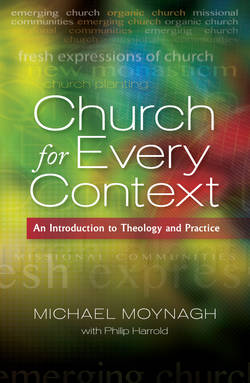Читать книгу Church for Every Context - Michael Moynagh - Страница 78
На сайте Литреса книга снята с продажи.
Corridors
ОглавлениеSecond, it seems that semi-autonomous ‘corridors’ are starting to be cleared within the inherited church for new contextual communities. In the Church of England, BMOs (Bishops’ Mission Orders) could enable local churches to develop and lead networks of new congregations that jump local-church boundaries. A church in Bristol, for instance, has been given a BMO that allows it to initiate gatherings broadly anywhere in the north of the city. It is not hard to imagine such a church growing new congregations, networking them to provide mutual support, producing its own leaders whom it trains and employs to establish further gatherings, and in time becoming a substantial presence within the diocese.
The CMS (Church Mission Society) has been recognized as an ‘acknowledged community’, which is a religious order. This allows it to form missional communities within the Church of England that are more independent of dioceses than the typical Anglican church. As an acknowledged community, CMS has a bishop (currently the Bishop of Coventry) who exercises oversight and is entitled to ordain ministers to serve within the community. In 2010, CMS launched a training course for lay (and now ordained) pioneers, and is likely to deploy them in collaboration with local churches and to offer them continuing support.
The Church Army, too, is in the process of becoming an acknowledged community. It currently trains and deploys Church of England evangelists, many of whom are pioneering contextual churches. Given its heritage of supporting lay evangelists, it would not be a large step for the Church Army to host an ecumenical third order of lay church planters, who would have an allegiance to their denomination but receive training and ongoing support under its auspices.
Other dispersed missional orders are emerging as part of the renewed interest in monasticism. They include The Order of Mission (TOM), which grew to over 350 members worldwide between 2003 and 2010 (Kershaw, 2010, p. 80), the 24–7 ecumenical global prayer movement among young people that has expanded to 90 nations in ten years (Freeman, 2010, p. 50) and the Northumbria community, which has been longer established.
Church founders may find it more attractive to bring communities to birth under these BMO or religious-order umbrellas, where the ethos is favourable, than to struggle on their own within the existing structures of the church, where contextual church is often misunderstood and support inadequate. These networks would provide various kinds of support, such as negotiating with the wider church on founders’ behalf to clear away misunderstandings and obstacles.
The Methodist Church also has a tradition of religious orders, such as the Methodist Diaconal Order, which uses the language of pioneering to describe its role. Might this Order eventually become a focus for fresh expressions or might a separate ‘fresh expressions’ order emerge? Churches Together in Lincolnshire are forming an ecumenical lay order of pioneers. What other ‘corridors’ might open up?
